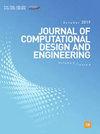Vibration analysis of electric motors considering rotating rotor structure using flexible multibody dynamics-electromagnetic-structural vibration coupled analysis
IF 6.1
2区 工程技术
Q1 COMPUTER SCIENCE, INTERDISCIPLINARY APPLICATIONS
引用次数: 0
Abstract
In this study, we develop flexible multibody dynamic-electromagnetic-structural vibration coupled analysis method to accurately predict motor vibration by considering the electromagnetic force characteristics, rotating characteristics of rotating motor motors, and their interactions at the no-load rated speed and operating speed range. The structural characteristics are accurately reflected by developing a 3-D finite element model considering the entire components of the motor. The reliability of the 3-D finite element model of the motor is verified using the impact hammer test. In addition, to consider the rotational characteristics of the rotor structure, we develop a flexible multibody dynamics model that connects the flexible rotor and the bearing with revolute joint. The vibration of the motor at the no-load rated speed is analyzed using flexible multibody dynamics-electromagnetic-structural vibration coupled analysis. Comparing the vibration test results, it is confirmed that the flexible multibody dynamics-electromagnetic-structural vibration coupled analysis result predicts the actual motor vibration more accurately than the conventional finite element analysis-based electromagnetic-structural vibration coupled analysis result. By using flexible multibody dynamics-electromagnetic-structural vibration coupled analysis in the operating speed range, it is confirmed that not only electromagnetic force harmonics but also sideband harmonics caused by rotor eccentricity induced large vibrations, and also confirmed that it accurately predicts the vibration characteristics of actual motors with rotating rotors.采用柔性多体动力-电磁-结构耦合分析考虑旋转转子结构的电动机振动
在本研究中,我们建立了灵活的多体动力-电磁-结构振动耦合分析方法,通过考虑电磁力特性、旋转电机的旋转特性以及它们在空载额定转速和工作转速范围内的相互作用来准确预测电机的振动。通过建立考虑电机整体部件的三维有限元模型,准确地反映了电机的结构特性。通过冲击锤试验验证了电机三维有限元模型的可靠性。此外,考虑转子结构的转动特性,建立了将柔性转子与轴承通过转动关节连接起来的柔性多体动力学模型。采用柔性多体动力学-电磁-结构振动耦合分析方法对电机在空载额定转速下的振动进行了分析。对比振动试验结果,证实了柔性多体动力-电磁-结构振动耦合分析结果比传统基于有限元分析的电磁-结构振动耦合分析结果更准确地预测了电机的实际振动。通过在运行转速范围内的柔性多体动力学-电磁-结构振动耦合分析,证实了除了电磁力谐波外,转子偏心引起的边带谐波也会引起较大的振动,并证实了该方法能准确地预测实际转子旋转电机的振动特性。
本文章由计算机程序翻译,如有差异,请以英文原文为准。
求助全文
约1分钟内获得全文
求助全文
来源期刊

Journal of Computational Design and Engineering
Computer Science-Human-Computer Interaction
CiteScore
7.70
自引率
20.40%
发文量
125
期刊介绍:
Journal of Computational Design and Engineering is an international journal that aims to provide academia and industry with a venue for rapid publication of research papers reporting innovative computational methods and applications to achieve a major breakthrough, practical improvements, and bold new research directions within a wide range of design and engineering:
• Theory and its progress in computational advancement for design and engineering
• Development of computational framework to support large scale design and engineering
• Interaction issues among human, designed artifacts, and systems
• Knowledge-intensive technologies for intelligent and sustainable systems
• Emerging technology and convergence of technology fields presented with convincing design examples
• Educational issues for academia, practitioners, and future generation
• Proposal on new research directions as well as survey and retrospectives on mature field.
 求助内容:
求助内容: 应助结果提醒方式:
应助结果提醒方式:


